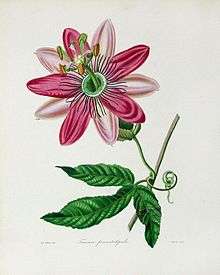Passiflora pinnatistipula
Passiflora pinnatistipula, commonly known as poro poro or gulupa[1] (Colombia), is a climbing perennial that grows in the Cajamarca region of Peru and the departments of Cundinamarca and Boyaca[2] in Colombia produce the purple variety; the yellow, "Hawaiiana" variety is mainly grown in the Valley of Cauca. It has also been cultivated in Australia, India, U.S. (Hawaii & Florida), Kenya, Java, Sumatra, Malaysia, Fiji, Papua New Guinea and Taiwan.[3] It is listed on the Ark of Taste with other San Marcos Andean Fruits that are in danger of extinction. It produces impressive flowers and yellow fruit with an oblong shape containing many small seeds. The flesh is reminiscent of an orange and is used for beverages, jams, sorbets and salad dressing.[4]
| Passiflora pinnatistipula | |
|---|---|
 | |
| Scientific classification | |
| Kingdom: | Plantae |
| Clade: | Tracheophytes |
| Clade: | Angiosperms |
| Clade: | Eudicots |
| Clade: | Rosids |
| Order: | Malpighiales |
| Family: | Passifloraceae |
| Genus: | Passiflora |
| Species: | P. pinnatistipula |
| Binomial name | |
| Passiflora pinnatistipula | |
References
- http://ciatweb.ciat.cgiar.org/ipgri/fruits_from_americas/frutales/Ficha%20Passiflora%20pinnatistipula.htm
- http://www.elcolombiano.com/BancoConocimiento/E/exquisitos_derivados_de_la_deliciosa_gulupa/exquisitos_derivados_de_la_deliciosa_gulupa.asp
- http://fshs8813.wpengine.com/proceedings-o/1967-vol-80/320-330%20(MORTON).pdf
- "Archived copy". Archived from the original on 2013-04-15. Retrieved 2012-06-26.CS1 maint: archived copy as title (link)